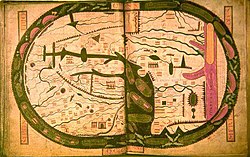Beatus of Liébana
This article includes a list of references, related reading, or external links, but its sources remain unclear because it lacks inline citations. (April 2019) |
Saint Beatus | |
|---|---|
 The world map from the Saint-Sever Beatus measuring 37 X 57 cm. This was painted c. 1050 as an illustration to Beatus's work at the Abbey of Saint-Sever in Aquitaine, on the order of Gregori de Montaner, Abbot from 1028 to 1072. | |
| Born | c. 730 Duchy of Cantabria, Kingdom of Asturias |
| Died | c. 800 Liébana, Cantabria, Kingdom of Asturias |
| Venerated in | Roman Catholic Church Orthodox Catholic Church |
| Feast | February 19 |

Saint Beatus of Liébana (Template:Lang-es; c. 730 – c. 800) was a monk, theologian, and geographer from the former Duchy of Cantabria and Kingdom of Asturias, in modern Cantabria, northern Spain, who worked and lived in the Picos de Europa mountains of the region of Liébana. He is best remembered today as the author of the Commentary on the Apocalypse.
Biography
Beatus was likely born and raised in Liébana, possibly from a poor family. As confessor to Queen Adosinda, wife of Silo of Asturias, and as teacher of Alcuin of York and Etherius of Osma, Beatus exercised wide influence.[2]
He is best remembered today as the author of the Commentary on the Apocalypse, written in 776, then revised in 784 and again in 786. The Commentary was popular during the Middle Ages and survives in at least 34 manuscripts (usually called a beatus) from the 10th through the 16th centuries. Not all of the manuscripts are complete, and some exist only in fragmentary form. Twenty-six of these manuscripts are lavishly decorated in the Mozarabic, Romanesque, or Gothic style of illumination.
Beatus was a strong opponent of the Adoptionist Christology put forward by Elipandus, Bishop of Toledo and founder of the Adoptivi, and Bishop Felix of Urgell in the Iberian Peninsula. Elipandus and Felix declared that Jesus, in respect to his human nature, was the adopted son of God by God's grace, thus emphasizing the distinction between the divinity and the humanity of Christ. Beatus and other opponents of adoptionism, such as Alcuin and Paulinus II of Aquileia, feared that this view would so divide the person of the Savior that the reality of the incarnation would be lost. In addition, many theologians were concerned that this adoptionism was a new version of the Nestorianism advanced by Nestorius. This debate largely died with the deaths of the proponents.[3]
Author and theologian
The Commentary on the Apocalypse is a work of erudition but without great originality, made up principally of compilations. Beatus includes long extracts from the texts of the Fathers of the Church and Doctors of the Church, especially Augustine of Hippo, Ambrose, Ticonius, Irenaeus, and Isidore of Seville. He adds to this the commentary on the Book of Daniel by Jerome.
The Beatus text was regarded as a symbol of Christian resistance to the Muslims who dominated much of the Iberian Peninsula (see al-Andalus) in the early Middle Ages.
See also
References
- ^ Beatus of Liébana. "Monstrous Cavalry, Beatus de Saint-Sever". Commentary on the Apocalypse.
- ^ "St. Beatus of Liébana", Christ in the Desert Monastery Archived 2014-03-03 at the Wayback Machine
- ^ González, Justo L. (2010). A History of Christian Thought Volume II: From Augustine to the Eve of the Reformation. Abingdon Press. p. 109-111. ISBN 9781426721915. Retrieved 7 January 2018.
Further reading
For more information on Beatus of Liébana or on the Beatus Apocalypse manuscripts, see the studies carried out by John Williams, Mireille Mentre, José Camón Aznar, Wilhelm Neuss and Joaquín Yarza Luaces.
- Cancionero de Liébana 1977 ("Collection of verse of Liebana", 1977). Republished in 2006. Written by the Spanish poet from Cantabria Matilde Camus.
- Brigitte Englisch: Ordo orbis terrae. Die Weltsicht in den Mappae mundi des frühen und hohen Mittelalters. Berlin 2002, ISBN 3-05-003635-4, S. 171 ff.
- Forbes, Andrew; Henley, David (2012). Apocalypse: The Illustrated Book of Revelation. Chiang Mai: Cognoscenti Books. ASIN: B008WAK9SS

